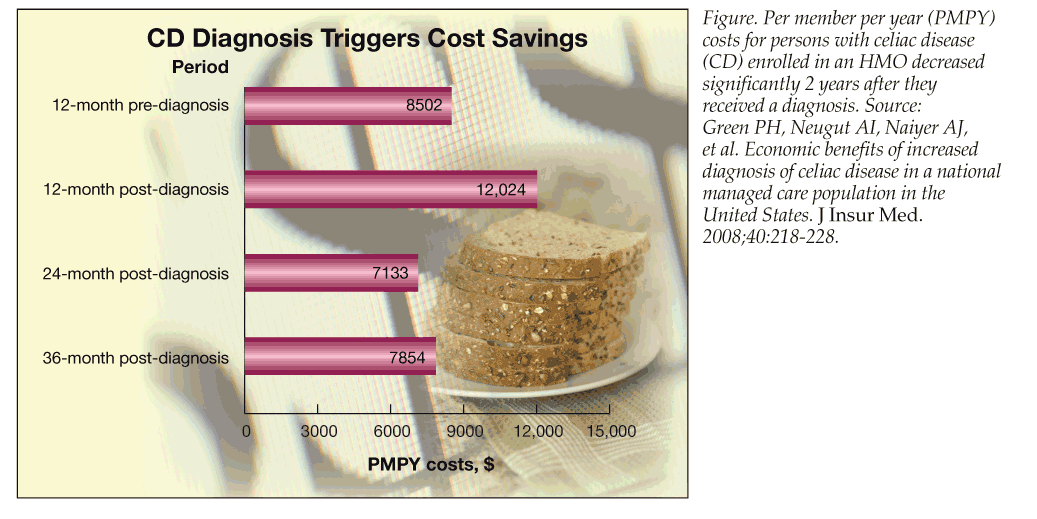- Clinical Technology
- Adult Immunization
- Hepatology
- Pediatric Immunization
- Screening
- Psychiatry
- Allergy
- Women's Health
- Cardiology
- Pediatrics
- Dermatology
- Endocrinology
- Pain Management
- Gastroenterology
- Infectious Disease
- Obesity Medicine
- Rheumatology
- Nephrology
- Neurology
- Pulmonology
Recognition of Celiac Disease Reduces Costs
An increase in the rate of celiac disease (CD) diagnosis resulted in a significant reduction in direct medical costs and utilization of health care services, according to a team of researchers led by Peter H. R. Green, MD, professor of clinical medicine and director of the Celiac Disease Center, Columbia University College of Physicians and Surgeons, New York. CD occurs in genetically predisposed persons because of an immune response to gluten, the protein component of wheat, rye, and barley, and affects about 1% of the US population; however, CD goes undiagnosed in many persons. Study findings were published in the December 2008 issue of the Journal of Insurance Medicine.An increase in the rate of celiac disease (CD) diagnosis resulted in a significant reduction in direct medical costs and utilization of health care services, according to a team of researchers led by Peter H. R. Green, MD, professor of clinical medicine and director of the Celiac Disease Center, Columbia University College of Physicians and Surgeons, New York. CD occurs in genetically predisposed persons because of an immune response to gluten, the protein component of wheat, rye, and barley, and affects about 1% of the US population; however, CD goes undiagnosed in many persons. Study findings were published in the December 2008 issue of the Journal of Insurance Medicine.Using claims, encounter, and eligibility data of about 10.2 million enrollees in US managed care plans between January 1999 and December 2003, the researchers compared direct medical costs and use of selected health care services among 4 cohorts. The team identified 525 persons 62 years and younger who received a new diagnosis of CD, were continuously enrolled in the managed care health plan during the 12 months before diagnosis, and were not eligible for Medicare during the 3-year follow-up period. Three control groups were also identified: persons without a CD diagnosis but who exhibited 1 (cohort 1, N = 1109), 2 (cohort 2, N = 1038), or 3 or more (cohort 3, N = 980) systemic, GI, or nutritional manifestations of symptoms associated with CD.The researchers found that the direct medical costs of the CD-diagnosed cohort changed dramatically during the period. Overall, the mean medical cost per member per year (PMPY) increased from $8502 in the 12-month pre-diagnosis period to $12,024 in the 12-month post-diagnosis period, then decreased to $7133 and $7854 in the 24-month and 36-month post-diagnosis periods, respectively (Figure). The team attributed the rise in PMPY costs during the first post-diagnosis period primarily to an increase in facility inpatient care. The study authors suggested that a decline in facility inpatient and emergency department utilization resulted in the cost savings realized during the 24-month and 36-month post-diagnosis periods.
An increase in the rate of celiac disease (CD) diagnosis resulted in a significant reduction in direct medical costs and utilization of health care services, according to a team of researchers led by Peter H. R. Green, MD, professor of clinical medicine and director of the Celiac Disease Center, Columbia University College of Physicians and Surgeons, New York. CD occurs in genetically predisposed persons because of an immune response to gluten, the protein component of wheat, rye, and barley, and affects about 1% of the US population; however, CD goes undiagnosed in many persons. Study findings were published in the December 2008 issue of the Journal of Insurance Medicine.
Using claims, encounter, and eligibility data of about 10.2 million enrollees in US managed care plans between January 1999 and December 2003, the researchers compared direct medical costs and use of selected health care services among 4 cohorts. The team identified 525 persons 62 years and younger who received a new diagnosis of CD, were continuously enrolled in the managed care health plan during the 12 months before diagnosis, and were not eligible for Medicare during the 3-year follow-up period. Three control groups were also identified: persons without a CD diagnosis but who exhibited 1 (cohort 1, N = 1109), 2 (cohort 2, N = 1038), or 3 or more (cohort 3, N = 980) systemic, GI, or nutritional manifestations of symptoms associated with CD.

The researchers found that the direct medical costs of the CD-diagnosed cohort changed dramatically during the period. Overall, the mean medical cost per member per year (PMPY) increased from $8502 in the 12-month pre-diagnosis period to $12,024 in the 12-month post-diagnosis period, then decreased to $7133 and $7854 in the 24-month and 36-month post-diagnosis periods, respectively (Figure). The team attributed the rise in PMPY costs during the first post-diagnosis period primarily to an increase in facility inpatient care. The study authors suggested that a decline in facility inpatient and emergency department utilization resulted in the cost savings realized during the 24-month and 36-month post-diagnosis periods.
